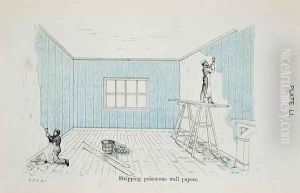Thomas Pridgin Teale Paintings
Thomas Pridgin Teale was an English surgeon, rather than a traditional artist. Born on January 5, 1800, in Leeds, Yorkshire, Teale was known more for his contributions to the medical field than to the arts. He studied at the Leeds Grammar School and later attended the University of Edinburgh, where he received his medical degree in 1820. Teale was a prominent figure in surgery and medical education during the 19th century, particularly in the Leeds area.
After completing his studies, Teale returned to Leeds, where he began his medical practice. He became a house surgeon at the Leeds General Infirmary and later a full surgeon, a position he held for many years. Throughout his career, Teale focused on a variety of medical issues but was particularly interested in ophthalmic surgery and the treatment of deformities. He was known for his meticulous surgical techniques and his advocacy for conservative approaches to treatment, emphasizing the body's natural healing processes over more aggressive interventions.
Apart from his surgical practice, Teale made significant contributions to medical literature. He authored several influential texts, including 'A Practical Treatise on Neuralgic Diseases, Dependent Upon Irritation of the Spinal Marrow and Ganglia of the Sympathetic Nerve' (1834), which reflected his interest in nervous system disorders. Teale was also dedicated to medical education, teaching at the Leeds School of Medicine, where he influenced many students with his clinical skills and medical philosophy.
Despite his medical focus, if there are any artistic connections to Thomas Pridgin Teale, they may lie in the detailed anatomical drawings and observations that were common in medical texts of the time, which required a certain level of artistic skill. However, Teale is not primarily recognized for any artistic endeavors in the conventional sense, such as painting or sculpture, but rather for his contributions to the medical profession.
Thomas Pridgin Teale passed away on November 21, 1868, in Leeds. His legacy as a surgeon and medical educator has marked him as a notable figure in the history of British medicine during the Victorian era. His work and teachings continued to influence medical practices well after his death.
